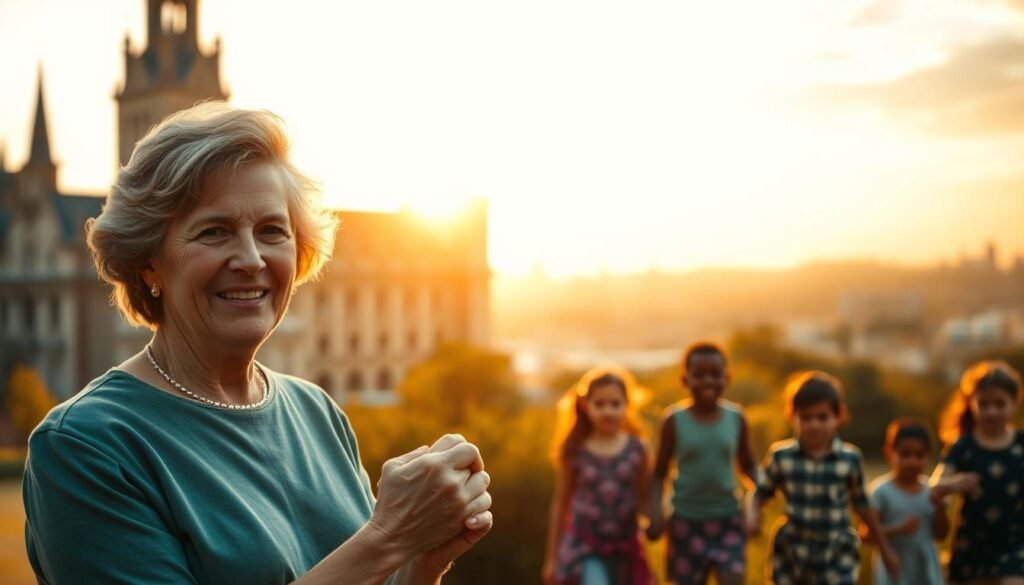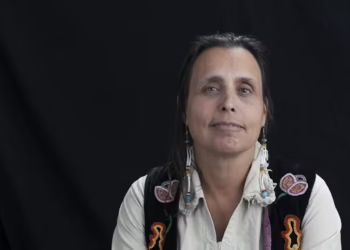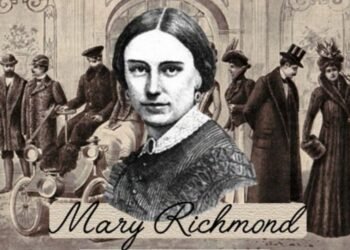One striking fact: in 1919 a small leaflet campaign and a Trafalgar Square arrest helped start a global charity that has shaped how the world counts and protects its children.
The group began as a direct response to images of starving youngsters after World War I. A determined woman turned protest into action, chartering ships and sending tons of food and medicine across borders.
Her name became tied to a rights-based mission. By 1924 she presented a Declaration that reframed a child as a holder of rights. That idea grew into movements and treaties that, over 100 years, changed how people measure progress.
Key Takeaways
- Founding moment: a leaflet campaign led to an arrest and the first public donations.
- Early action included seaborne relief that saved lives and showed practical charity in crisis.
- The 1924 Declaration reframed children’s rights and inspired later UN instruments.
- Save the Children grew from local aid to an international movement that changed policy and practice.
- The organization’s work over 100 years proved measurable: fewer deaths, more schooling, and reduced harm to children.
Eglantyne Jebb: Early Life, Education, and the Making of a Reformer
A childhood at The Lyth in Shropshire quietly shaped a future reformer who would put children first. Born in 1876 into a close-knit, faith-driven family, she learned early that duty and compassion mattered. Her governess, Heddie from Alsace, taught French and German and told stories of oppression that widened her view of the world.

At Lady Margaret Hall, Oxford, she favored austere study over comfort and kept a steady literary practice, even reworking the myth of a box into a moral tale. Influential women at Cambridge, such as Mary Marshall and Florence Keynes, recognized her analytical gift and urged practical inquiry.
Working in the Charity Organisation Society office, she researched squalid housing, contaminated wells, and outbreaks of typhoid and smallpox. Her 1906 “Cambridge: A Social Study” combined data and prescription, calling for volunteer training and better coordination among charities.
The work of teaching schoolchildren and visiting their homes tied education to health. In a city remembered since the era of queen victoria, she put marginalized people at the center and turned careful research into a method that would drive later action.
Founding the Save the Children Fund and a New Kind of Humanitarian Action
In the spring of 1919 a small protest in Trafalgar Square set off a chain of events that changed humanitarian aid.
In May 1919, eglantyne jebb handed out leaflets and chalked “End the Blockade” and “Fight the Famine” to call attention to children dying from postwar shortages. She was arrested and stood in a public case where, unexpectedly, Crown Prosecutor Sir Archibald Bodkin paid the £5 fine the next day.
The headlines fueled a big meeting at the royal albert hall. Hecklers tried to disrupt the crowd with vegetables, but her appeal—“Surely it is impossible for us…to watch children starve to death, without making an effort to save them”—won support and donations that launched the save children fund.
Earlier that year she and her sister, dorothy buxton, had formed the fight famine council to build momentum. By January 6, 1920, a meeting in Geneva created an international children fund to unite people and faiths across the world.
Relief moved fast: in 1921 the SS Torcello sailed with 600 tons of food and medical supplies. Skeptics who said no one would give for enemy children were proved wrong as trade unions, churches, and ordinary people stepped in to support the cause.

Children’s Rights Take Center Stage: From the Declaration to the UN Convention
A short, bold declaration in Geneva turned relief work into a global rights agenda for children.
The 1924 League of Nations meeting gave formal standing to a simple list of duties: feed the hungry child, nurse the sick child, shelter the orphan and waif. That declaration reframed aid as obligation, not charity, and helped shape later human rights thinking.
The 1924 League of Nations and the Declaration of the Rights of the Child
The League endorsed the declaration, making a lasting public statement about claims every child holds on society. This early step proved crucial when the United Nations revisited the idea in 1959 and again in 1989.
From 1959 to 1989: how Jebb’s vision shaped the UN Convention on the Rights of the Child
The 1959 statement extended the declaration, and the 1989 convention turned many principles into a global standard. Rights language sharpened accountability with concrete duties that governments and people could measure and enforce.
Save the Children in the United States: programs, education, and protection in conflict and war
In the U.S., save children work began in 1932 in Appalachia with food, clothes, books, and school lunches. Today programs span 14 states, focusing on education and protection, and leading in responses when conflict or war threatens children.
The difference is clear: rights bring structure to support, guide policy, and turn commitments made in a meeting or on a day into daily work that saves lives.
Eglantyne Jebb the Person: Women’s Rights Advocate, Writer, and Global Voice
She moved between protest lines and refugee camps, turning observation into organized action.
Suffrage marches, Balkans relief, and advocating for refugees
She joined suffrage marches, marching with other women who demanded the vote and broader civic reform.
This political work linked rights for adults to protection for the vulnerable, especially the child in crisis.
In 1913 she traveled to the Balkans amid conflict over Macedonia. There she saw families displaced by war, children in bread lines, and makeshift care stations.
Those scenes pushed her to raise funds and build networks that crossed borders to serve a common cause.
Also wrote novels and challenged conventions
Alongside relief work she also wrote romantic novels and essays. Her literary voice proved a gift for persuasion.
Field reports and fiction worked together. Stories made distant crises feel immediate to people at home.
Her varied work — teaching, research, writing, and relief — shaped a public voice that influenced policy for children across the world.
Her advocacy came from firsthand evidence, not theory. That grounded approach helped turn sympathy into systems that endured for many years.
Conclusion
A single leaflet, a courtroom case, and a bold appeal at the Royal Albert Hall turned outrage into organized action for children.
For more than 100 years, eglantyne jebb and colleagues built the save children movement from street leaflets to an international office that delivers food, school support, and protection.
The 1924 league declaration rights child helped seed later human rights law and the 1989 convention. Dorothy Buxton’s early organizing also shaped the children fund’s rise.
Centenary tributes at royal albert hall and beyond show that a woman’s gift for turning shock into structure still matters. The story invites people to meet, support, and keep rights for every child real in practice.
FAQ
Who founded Save the Children International and why?
The organization was founded by a British social reformer who witnessed the effects of war and famine on children in the early 20th century. Motivated by urgent humanitarian need after World War I, she organized public appeals and relief efforts to deliver food, medical supplies, and education to starving children.
What early experiences shaped her commitment to child welfare?
Raised in a family that valued education and public service, she trained as a social researcher and exposed poverty through studies of urban life. Her time at university and subsequent research into health and sanitation inspired a lifelong focus on children’s nourishment, schooling, and rights.
How did a Trafalgar Square protest influence the charity’s founding?
A public demonstration in Trafalgar Square highlighted the scale of child suffering after the war. The protest led to an arrest and a fundraising appeal that raised funds crucial to starting the Save the Children Fund. A small initial donation helped launch organized relief work.
What role did the Royal Albert Hall appeal play in the movement?
A major appeal at the Royal Albert Hall drew public attention and funds for the “Fight the Famine” campaign. The event countered critics and mobilized donations and volunteers, enabling large-scale distribution of food and medical aid to affected regions.
How did the organization expand internationally?
After initial relief work, the movement established links with groups across Europe and set up an international office in Geneva. This helped coordinate cross-border aid, share best practices, and build an international union focused on child welfare and protection.
What practical relief operations did the charity run in its early years?
Early operations included chartering ships to deliver food and medicine, establishing feeding centers, and supporting field hospitals and schools. These efforts saved lives during famines and epidemics and laid the groundwork for long-term recovery and education programs.
How did the founder influence international policy on children’s rights?
She drafted a statement on children’s rights that was adopted by the League of Nations in 1924. That declaration set principles for child protection and later informed the 1959 Declaration of the Rights of the Child and the 1989 UN Convention on the Rights of the Child.
What connection exists between the 1924 declaration and the UN Convention of 1989?
The 1924 League of Nations declaration introduced core ideas about protection, nourishment, and education for children. Over decades, those principles were expanded, debated, and codified into the 1989 UN Convention, which established comprehensive legal rights for children worldwide.
How has Save the Children operated in the United States?
Save the Children in the U.S. runs programs focused on education, emergency response, and child protection in conflict zones. It supports school recovery, nutrition programs, and advocacy to keep children safe and learning during crises.
Was the founder involved in other social causes beyond child relief?
Yes. She campaigned for women’s rights, supported refugee relief in the Balkans, and wrote about social issues. Her activism extended to suffrage marches and public campaigns to improve conditions for displaced families.
Did she publish works or other writings?
She wrote reports, social studies, and shorter pieces aimed at raising awareness about poverty, health, and the effects of war on civilians. These writings helped sway public opinion and policy toward child-focused relief and reform.
How can people support the organization’s legacy today?
Support can take many forms: donating to modern child-focused charities, volunteering, advocating for policies that protect children, and spreading awareness about the history of child rights. Educational gifts and local initiatives also help young people directly.
Who were some contemporaries who worked alongside her in relief efforts?
Other notable figures included campaigners and aid organizers who focused on famine relief, refugee support, and international coordination. These allies helped organize appeals, distribute supplies, and promote the rights-based approach to child welfare.
What practical changes did early campaigns bring to children’s lives?
Early campaigns reduced mortality by providing food and medical care, reopened schools, and set up feeding programs. They demonstrated that coordinated public appeals and organized logistics could make a measurable difference in nutrition and survival.
Where can I learn more about the history and archives of the movement?
Historical records, archives, and biographies held by museums, universities, and the charity’s own archives detail campaigns, correspondence, and reports. Many libraries and online collections also host leaflets, meeting minutes, and contemporary press coverage for further research.





